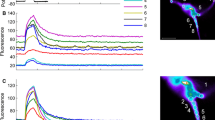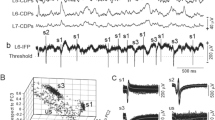Conclusions
The activity of slow-adapting (SA) and fast-adapting (FA) neurons of the crustacean stretch receptor under the influence of solutions of strychnine or procaine has been studied.
-
1.
In some experiments, under the influence of these drugs, the FA-neuron became slow-sdapting and exhibited spontaneous rhythmic activity.
-
2.
The transition to rhythmic prolonged action potentials (PAP) under the influence of these drugs took place more slowly in the FA-neuron than in the SA-neuron.
-
3.
Statistically significant results show that during the PAP plateau of the SA-neuron the frequency of action potentials (AP) of the FA-neuron was increased. The PAP of the SA-neuron also facilitated the onset of double APs during the plateau, together with an increase in duration and amplitude and the earlier appearance of PAPs in the FA-neuron.
-
4.
The results obtained may be explained by the effect of the electric field created by high-voltage, prolonged depolarization of the membrane of the SA-neuron during the PAP plateau, and by high sensitivity of the FA-neuron, in a state of spontaneous activity, to the external electric field.
-
5.
The results of this investigation demonstrate that an ephaptic link is possible between neurons, which would facilitate hybersynchronization of neuronal activity in an eplleptic focus.
Similar content being viewed by others
References
BELENKOV, N.Yu. and V.D. CHIRKOV Zh. Vyssh. Nervn. Deyatel'nosti im. I.P. Pavlova. 11:512, 1961.
BELENKOV, N.Yu. and V.D. CHIRKOV Zh. Vyssh. Nervn. Deyatel'nosti im. I.P. Pavlova. 14:68, 1964.
BELENKOV, N.Yu. and V.D. CHIRKOV. Zh. Vyssh. Nervn. Deyatel'nosti im. I.P. Pavlova. 15:128, 1965.
LIVANOV, M.N. In: Problems in Electrophysiology and Electroencephalography. Moscow—Leningrad, 1960, p. 11.
MORELL, F. Fiziol. Zh. SSSR im. I.M. Secherova, 48:251, 1962.
PENFIELD, W. and H. JASPER. Epilepsy and the Functional Anatomy of the Brain. Moscow, 1958.
RUSINOV, V.S. Zh. Vyssh. Nervn. Deyatel'nosti im. I.P. Pavlova. 11:776, 1961.
FESSARD, A. In: Problems in General Neurophysiology and Higher Nervous Activity. Moscow, 1961, p. 239.
BENNETT, M.V.L., E. ALJURE, Y. NAKAJIMA and G.D. PAPPASScience, 141:262 1963.
BODIAN, D. and R.A. BERGMAN Bull. Johns Hopkins Hospital, 110:78, 1962.
BREMER F. Proc. Soc. Exp. Biol. Med. 46:527, 1941.
BREMER, F. Physiol. Rev. 38:357, 1958.
ENOMOTO, T.E. and C. AJMONE-MARSAN. Electroencephalogr. Clin. Neurophysiol. 11:199, 1959.
FESSARD, A. In: Bases Physiologiques et Aspects de l'Epilepsie. Paris, 1958, p. 37.
FESSARD, A. In: Progress in Brain Research, 1:263, 1963.
FLOREY, E. and E. FLOREY J. Gen. Physiol. 39:69, 1955.
FRANK, K. and M.G.F. FUORTES. J. Physiol. (London) 134:451, 1956.
FRUKAWA, T. and E.J. FURSHPAN. J. Neurophysiol. 26:140, 1963.
GERARD, R.W. In: Handbook of Physiology, S. 1, 3, 1960.
HAGIWARA, S. and H. MORITA J. Neurophysiol. 25:721, 1962.
JASPER, H. Arch. Neurol. Psychiat. 44:1435, 1940.
KANDEL, E.R. and W.A. SPENCER. J. Neurophysiol. 24:243, 1961.
KARLSON, U. and R. SCHULZ. Nature, 201:1230, 1964.
LI, C.L. J. Neurophysiol. 22:438, 1959.
LIBET, B. and R. W. GERARD. J. Neurophysiol. 2:153, 1939.
MARTIN, A.R. and G. PILAR. J. Physiol. (London) 168:443, 1963.
MATSUMOTO, H. and C. AJMONE-MARSAN. Exp. Neurol. 9:286, 1964.
MATSUMOTO, N. and C. AJMONE-MARSAN. Exp. Neurol. 9:305, 1964.
PETERSON, R.P. and F.A. PEPE. J. Biophys. Biochem. Cytol. 11:157, 1961.
PURPURA, D.P., J.G. McMURTRY, C.F. LEONARD and A. MALLIANI. J. Neurophysiol. 29:954, 1966.
SAWA, M., N. MARUYAMA and S. KAJI. Electroencephalogr. Clin. Neurophysiol. 15:209, 1963.
STRUMWASSER, F. and S. ROSENTHAL. Amer. J. Physiol. 198:405, 1960.
TERZUOLO, C.A. and T.H. BULLOCK. Proc. Nat. Acad. Sci. U.S.A. 42:687, 1956.
WASHIZU, Y. Comp. Biochem. Physiol. 15:535, 1965.
WHITEAR, M. Phil. Trans. Roy. Soc. London Ser. B. Biol. Sci. B 248:437, 1965.
Author information
Authors and Affiliations
Rights and permissions
About this article
Cite this article
Rusinov, V.S., Ezrokhi, V.L. Possibility of ephaptic interaction of neurons through an electric field generated by them. Neurosci Behav Physiol 1, 469–476 (1967). https://doi.org/10.1007/BF01126542
Issue Date:
DOI: https://doi.org/10.1007/BF01126542




